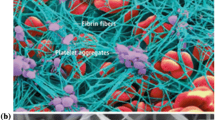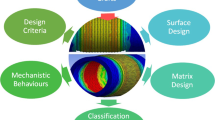Abstract
This work aims to investigate the effects of plaque eccentricity and composition on the stent performance and stress distributions of plaque and artery during stenting by the finite element method. Three-dimensional stent–plaque–artery models for plaques with five different eccentricities and four different compositions were simulated, and the influences on stent recoil, stent plastic strain, stent foreshortening, stress distributions of artery and plaque, and lumen gain were studied. The results show that greater plaque eccentricity leads to greater stent recoil, stent plastic strain, stent foreshortening, maximum von Mises stresses of artery and plaque, and volume percentage of plaque in higher stress. Plaque composition exerts a great effect on all indices except the maximum von Mises stress of artery. The lipid pool declines stent recoil, but increases the maximum plastic strain of stent due to its softness, while the fibrous cap reduces stent foreshortening. Because of the existence of fibrous cap/calcified zones, plaque with greater eccentricity and higher mixture of components is more vulnerable during stenting process; thus, a larger expanding pressure should be carefully applied and a slightly longer stent should be used. The present study suggests that the real plaque geometry and composition in numerical simulations should be considered as an integral part of stent design and development, also is useful in enhancing our understanding of the mechanics of stent–plaque–artery interaction during stent implantation to improve the stent’s long-term clinical outcome.








Similar content being viewed by others
References
Barati E, Halabian M, Karimi A, Navidbakhsh M (2014) Numerical evaluation of stenosis location effects on hemodynamics and shear stress through curved artery. J Biomater Tissue Eng 4:358–366
Capelli C, Bosi GM, Cerri E, Nordmeyer J, Odenwald T, Bonhoeffer P, Migliavacca F, Taylor AM, Schievano S (2012) Patient-specific simulations of transcatheter aortic valve stent implantation. Med Biol Eng Comput 50:183–192
Carew TE, Vaishnav RN, Patel DJ (1968) Compressibility of the arterial wall. Circul Res 23:61–68
Cowley MJ, Dorros G, Kelsey SF, Van Raden M, Detre KM (1984) Acute coronary events associated with percutaneous transluminal coronary angioplasty. Am J Cardiol 53:C12–C16
Dabus G, Gerstle RJ, Derdeyn CP, Cross DT III, Moran CJ (2006) Endovascular treatment of the vertebral artery origin in patients with symptoms of vertebrobasilar ischemia. Neuroradiology 48:917–923
Demanget N, Duprey A, Badel P, Orgeas L, Avril S, Geindreau C, Albertini JN, Favre JP (2013) Finite element analysis of the mechanical performances of 8 marketed aortic stent-grafts. J Endovasc Ther 20:523–535
Dirk A, Stefan K, Rolf F, Wilhelm HH, Udo S (1996) Coronary plaque morphology affects stent deployment: assessment by intracoronary ultrasound. Catheter Cardiovasc Diagn 38:229–235
Douglas GR, Phani AS, Gagnon J (2014) Analyses and design of expansion mechanisms of balloon expandable vascular stents. J Biomech 47:1438–1446
Feenstra PH, Taylor CA (2009) Drug transport in artery walls: a sequential porohyperelastic-transport approach. Comput Method Biomech 12:263–276
Fitzgerald PJ, Oshima A, Hayase M et al (2000) Final results of the can routine ultrasound influence stent expansion (CRUISE) study. Circulation 102:523–530
Gervaso F, Capelli C, Petrini L, Lattanzio S, Di Virgilio L, Migliavacca F (2008) On the effects of different strategies in modelling balloon-expandable stenting by means of finite element method. J Biomech 41:1206–1212
Gokgol C, Diehm N, Nezami FR, Buchler P (2015) Nitinol stent oversizing in patients undergoing popliteal artery revascularization: a finite element study. Ann Biomed Eng 43:2868–2880
Holmes DR, Kereiakes DJ, Garg S, Serruys PW, Dehmer GJ, Ellis SG, Williams DO, Kimura T, Moliterno DJ (2010) Stent thrombosis. J Am Coll Cardiol 56:1357–1365
Holzapfel GA, Sommer G, Regitnig P (2004) Anisotropic mechanical properties of tissue components in human atherosclerotic plaques. J Biomech Eng 126:657–665
Holzapfel GA, Sommer G, Gasser CT, Regitnig P (2005) Determination of layer-specific mechanical properties of human coronary arteries with nonatherosclerotic intimal thickening and related constitutive modeling. Am J Physiol Heart Circ Physiol 289:H2048–H2058
Huang H, Virmani R, Younis H, Burke AP, Kamm RD, Lee RT (2001) The impact of calcification on the biomechanical stability of atherosclerotic plaques. Circulation 103:1051–1056
Karimi A, Navidbakhsh M, Shojaei A, Faghihi S (2013) Measurement of the uniaxial mechanical properties of healthy and atherosclerotic human coronary arteries. Mat Sci Eng C 33:2550–2554
Karimi A, Navidbakhsh M, Yamada H, Razaghi R (2014) A nonlinear finite element simulation of balloon expandable stent for assessment of plaque vulnerability inside a stenotic artery. Med Biol Eng Comput 52:589–599
Kiousis DE, Gasser TC, Holzapfel GA (2007) A numerical model to study the interaction of vascular stents with human atherosclerotic lesions. Ann Biomed Eng 35:1857–1869
Kumar RK, Balakrishnan KR (2005) Influence of lumen shape and vessel geometry on plaque stresses: possible role in the increased vulnerability of a remodelled vessel and the “shoulder” of a plaque. Heart 91:1459–1465
Lally C, Reid AJ, Prendergast PJ (2004) Elastic behavior of porcine coronary artery tissue under uniaxial and equibiaxial tension. Ann Biomed Eng 32:1355–1364
Lally C, Dolan F, Prendergast PJ (2005) Cardiovascular stent design and vessel stresses: a finite element analysis. J Biomech 38:1574–1581
Lee W, Cho SW (2018) A parametric approach to the probability of plaque rupture based on lumen geometry in coronary arteries using design of experiments. J Mech Sci Technol 32:1661–1666
Lee RT, Grodzinsky AJ, Frank EH, Kamm RD, Schoen FJ (1991) Structure-dependent dynamic mechanical behavior of fibrous caps from human atherosclerotic plaques. Circulation 83:1764–1770
Lee RT, Richardson SG, Loree HM, Grodzinsky AJ, Gharib SA, Schoen FJ, Pandian N (1992) Prediction of mechanical properties of human atherosclerotic tissue by high-frequency intravascular ultrasound imaging. An in vitro study. Arterioscler Thromb Vasc Biol 12:1–5
Li ZY, Howarth S, Trivedi RA, U-King-Im JM, Graves MJ, Brown A, Wang L, Gillard JH (2006) Stress analysis of carotid plaque rupture based on in vivo high resolution MRI. J Biomech 39:2611–2622
Loree HM, Grodzinsky AJ, Park SY, Gibson LJ, Lee RT (1994) Static circumferential tangential modulus of human atherosclerotic tissue. J Biomech 27:195–204
Marsico F, De Servi S, Kubica J, Angoli L, Bramucci E, Valentini P, Klersy C, Specchia G (1995) Influence of plaque composition on luminal gain after balloon angioplasty, directional atherectomy, and coronary stenting. Am Heart J 130(5):971–975
Meier B, Gruentzig AR, Hollman J, Ischinger T, Bradford JM (1983) Does length or eccentricity of coronary stenoses influence the outcome of transluminal dilatation? Circulation 67:497–499
Migliavacca F, Petrini L, Massarotti P, Schievano S, Auricchio F, Dubini G (2004) Stainless and shape memory alloy coronary stents: a computational study on the interaction with the vascular wall. Biomech Model Mechanobiol 2:205–217
Moliterno DJ (2005) Healing achilles—sirolimus versus paclitaxel. N Engl J Med 353:724–727
Mori K, Saito T (2005) Effects of stent structure on stent flexibility measurements. Ann Biomed Eng 33:733–742
Murphy BP, Savage P, McHugh PE, Quinn DF (2003) The stress–strain behavior of coronary stent struts is size dependent. Ann Biomed Eng 31:686–691
Naghavi M, Libby P, Falk E, Casscells SW, Litovsky S, Rumberger J et al (2003) From vulnerable plaque to vulnerable patient: a call for new definitions and risk assessment strategies: part I. Circulation 108:1664–1672
Nath FC, Muller DWM, Ellis SG, Rosenschein U, Chapekis A, Quain L, Zimmerman C, Topol EJ (1993) Thrombosis of a flexible coil coronary stent: frequency, predictors and clinical outcome. J Am Coll Cardiol 21:622–627
Ogden RW (1997) Non-linear elastic deformations. Courier Corporation, Chelmsford
Pant S, Limbert G, Curzen NP, Bressloff NW (2011) Multiobjective design optimisation of coronary stents. Biomaterials 32:7755–7773
Pant S, Bressloff NW, Limbert G (2012) Geometry parameterization and multidisciplinary constrained optimization of coronary stents. Biomech Model Mechanobiol 11:61–82
Pericevic I, Lally C, Toner D, Kelly DJ (2009) The influence of plaque composition on underlying arterial wall stress during stent expansion: the case for lesion-specific stents. Med Eng Phys 31:428–433
Pham T, Deherrera M, Sun W (2014) Finite element analysis of the biomechanical interaction between coronary sinus and proximal anchoring stent in coronary sinus annuloplasty. Comput Method Biomech 17:1617–1629
Qiao A, Zhang Z (2014) Numerical simulation of vertebral artery stenosis treated with different stents. J Biomech Eng. https://doi.org/10.1115/1.4026229
Sasaki K, Tomooka Y, Takeda R, Syaifudin A (2018) Deformation analysis of self-expanding stent considering plaque and a new expanding mechanism. EPI Int J Eng (EPIIJE) 1:98–106
Schiavone A, Zhao L (2015) The importance of vessel factors for stent deployment in diseased arteries. J Integr Cardiol 1(5):107–114
Syaifudin A, Takeda R, Sasaki K (2015) Effects of plaque lengths on stent surface roughness. Biomed Mater Eng 25:189–202
Tanimoto S, Bruining N, van Domburg RT, Rotger D, Radeva P, Ligthart JM, Serruys PW (2008) Late stent recoil of the bioabsorbable everolimus-eluting coronary stent and its relationship with plaque morphology. J Am Coll Cardiol 52:1616–1620
Taylor RA, Siddiq F, Suri MFK, Martin CO, Hayakawa M, Chaloupka JC (2008) Risk factors for in-stent restenosis after vertebral ostium stenting. J Endovasc Ther 15:203–212
Teng Z, Zhang Y, Huang Y, Feng J, Yuan J, Lu Q, Sutcliffe MP, Brown AJ, Jing Z, Gillard JH (2014) Material properties of components in human carotid atherosclerotic plaques: a uniaxial extension study. Acta Biomater 10:5055–5063
Timmins LH, Meyer CA, Moreno MR, Moore JE (2008) Effects of stent design and atherosclerotic plaque composition on arterial wall biomechanics. J Endovasc Ther 15:643–654
Wang WQ, Liang DK, Yang DZ, Qi M (2006) Analysis of the transient expansion behavior and design optimization of coronary stents by finite element method. J Biomech 39:21–32
Wei LL, Chen Q, Li ZY (2016) Study on the impact of straight stents on arteries with different curvatures. J Mech Med Biol 16:1650093
Wu W, Wang WQ, Yang DZ, Qi M (2007) Stent expansion in curved vessel and their interactions: a finite element analysis. J Biomech 40:2580–2585
Zhao S, Gu L, Froemming SR (2012) Performance of self-expanding nitinol stent in a curved artery: impact of stent length and deployment orientation. J Biomech Eng. https://doi.org/10.1115/1.4007095
Zunino P, D’Angelo C, Petrini L, Vergara C, Capelli C, Migliavacca F (2009) Numerical simulation of drug eluting coronary stents: mechanics, fluid dynamics and drug release. Comput Methods Appl Mech Eng 198:3633–3644
Acknowledgements
This study was supported by the Natural Science Foundation of China (NSFC) (Nos. 31300780, 11272091, 11422222, 31470043) and partially supported by the National 973 Basic Research Program of China (No. 2242018K3DN22) and ARC (FT140101152). The authors would like to acknowledge Prof. Leo Hwa Liang from National University of Singapore for his helpful suggestions in revising this article.
Author information
Authors and Affiliations
Corresponding authors
Additional information
Publisher’s Note
Springer Nature remains neutral with regard to jurisdictional claims in published maps and institutional affiliations.
Rights and permissions
About this article
Cite this article
Wei, L., Chen, Q. & Li, Z. Influences of plaque eccentricity and composition on the stent–plaque–artery interaction during stent implantation. Biomech Model Mechanobiol 18, 45–56 (2019). https://doi.org/10.1007/s10237-018-1066-z
Received:
Accepted:
Published:
Issue Date:
DOI: https://doi.org/10.1007/s10237-018-1066-z




